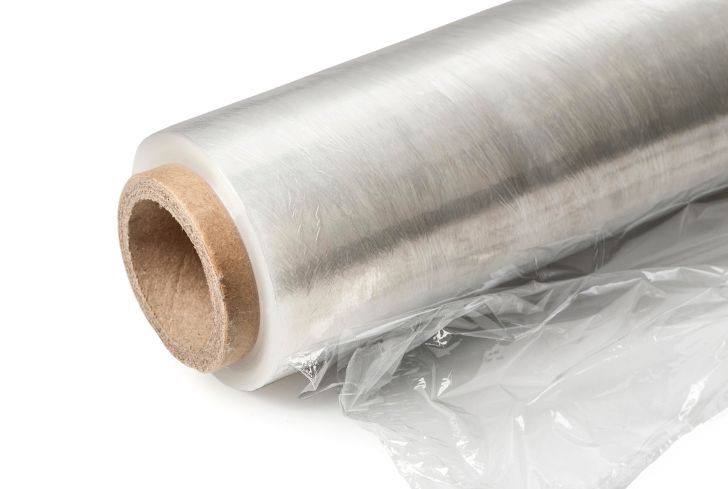We use cellophane in many ways – food preservation, storage, gift presentation, and product transportation. It is pretty resistant to bacteria or microbes in general, air, moisture, and even heat. This makes it a go-to option for packaging.
Christmas and festive seasons are also periods where you would be thankful for cellophane, and let’s not forget about arts and crafts. The cellophane industry is doing quite well, estimated to be worth $322 million in 2025.
It has become apparent from the market size of this commodity that consuming it without environmental consciousness is bad. And since biodegradability is becoming more and more achievable each year, is it possible that the cellophane industry has found a way to take advantage of technological advancements?
What is Cellophane Made Up of?
Cellophane is made of cellulose, a type of wood pulp. Carbon disulfide and dye are other substances that are added to cellophane during the manufacturing process. The manufacturer also submerges viscose in acid to turn it into cellulose. Then, it is softened with glycerol and lined with a layer of nitrocellulose lacquer to produce plastic and waterproof film.
Cellophane can also be dyed in an array of colors for decorative or functional purposes.
What is cellophane made of? Cellulose, nitrocellulose lacquer, and a release liner are the different ingredients you will find in cellophane.
There are two types of cellophane – true cellophane and synthetic cellophane. True cellophane is a product made from regenerated cellulose.
True cellophane is made of plant cellulose or wood pulp and a combination of other materials that you cannot recycle together. In contrast, synthetic cellophane is made of a plastic called polypropylene.
Propylene can be altered into the crystalline thermoplastic that makes polypropylene. This is still a type of plastic, albeit synthetic, and the best kind of material to recycle – you can recycle this plastic many times.
In other words, cellophane can be made up of two options – true and synthetic cellophane. Depending on what you are looking for, one has plant materials that make it organic, while the other is made from plastic, making it inorganic.
Is Cellophane Biodegradable?
Yes, most cellophane can biodegrade within a month. However, it is essential to note that there are two types of cellophane – true and synthetic. True cellophane is undiluted and all-natural and will break down in ten to thirty days if it is not coated with nitrocellulose lacquer.
However, if it is synthetic cellophane, it will not decompose fast. This is because it is made from polypropylene, a type of plastic that is better recycled than composted.
Polypropylene can be recycled as many times as possible. However, it will take two to three decades for biodegradation to take place, which contrasts with the idea of biodegradability. A biodegradable material breaks down fast, while a non-biodegradable one may decompose after constant and long-term exposure to UV rays.
A study may have found microbes capable of breaking synthetic cellophane down, but it takes several decades for this to happen. And the process is much different from what happens when microbes break down organic matter instead.
Plastic does not precisely break down; it instead becomes a plethora of micro and nanoplastics dispersed throughout the globe. This is why recycling cellophane made from plastic or polypropylene is better than allowing it to break down like regenerated cellulose.
On the other hand, biodegradable cellophane is made from plant material or regenerated cellulose. This material is susceptible to biodegradation; it will happen in 10 to 30 days, give, or take.
Exposure to the proper environment is essential during biodegradation. There must be sunlight, oxygen, and microbes, and the compost conditions must comply with composting standards.
Is Cellophane Compostable?
It depends on the type of cellophane in question. There are two groups, one compostable while the other isn’t. Cellophane made from wood pulp and natural materials breaks down fast. In contrast, plastic or synthetic cellophane requires up to a hundred years, give or take, to biodegrade.
Is cellophane compostable? The answer depends on the material the item is made from.
There are primarily two types in the market. One is synthetic, made from polypropylene or plastic polymers.
Plastic polymers are recyclable, but the downside is that you cannot compost them. If they get into the soil, they pollute it instead of providing nutrients or enhancing the environment.
Plastic does not decompose; instead, it breaks down into microplastics. Microplastics harm us and the environment because we have little control over how they disperse through biodiversity.
These tiny particles are volatile enough to travel for miles and can find their way into the atmosphere and the oceans.
It is best to avoid compositing this type of waste. But do you know what is even better than that?
Recycling it.
On the other hand, cellophane that is derived from bio-products will decompose when you compost it. This will happen within 10 to 30 days.
It is that fast because organic matter can easily be broken down into humus by microbes. However, if the cellophane film a layer of nitrocellulose, it will reduce the speed of the process.
In that case, the material will break down in two to three months.
Nitrocellulose is a chemical compound that is derived from nitric and sulfuric acid. It is a non-synthetic material applied to surfaces to strengthen them, creating resistance against microbes.

How Long Does It Take Cellophane to Decompose?
It takes cellophane ten to thirty days to decompose. But again, it can take up to twenty to thirty years to break down. There are two scenarios in this situation – the first refers to what happens when you compost true cellophane. The other refers to what happens when you attempt composting synthetic cellophane.
True cellophane breaks down because it is made of plant matter. The plant matter is biodegradable and will be broken down into humus within the shortest time.
This also makes it a great addition to your compost pile. If it has not been overly processed, it will provide nutrients to the plants and enhance the soil.
But even better, there will be no need to worry about the impacts of the results on the ecosystem because they will be positive.
In contrast, plastic cellophane will break down into microplastics within two to three decades. It may be longer or shorter, depending on environmental factors.
An extended period is not the only reason plastic should not be allowed to decompose in the environment. It can also release toxins into the ecosystem, from chemical fumes to its result, which is microplastics.
It is clear that the only cellophane material that should be allowed to decompose is that made from bioproducts. Synthetic cellophane is better recycled.
Is Cellophane Better Than Plastic?
Without a doubt. Cellophane is better than plastic for many reasons, and we will start with its sustainability status. Cellophane is more sustainable than plastic because of the material it is made from. True cellophane is made from renewable resources – cotton and hemp.
These resources replenish fast and are not at risk of depletion.
Conversely, plastic is made from crude oil or petroleum, a non-renewable natural resource. It is more environmentally friendly to rely on bioproducts than non-renewable resources. Currently, the world is not at risk of a depleted oil reserve, but if we don’t curb our excesses, this is something that can happen.
Eighty percent of the oil for consumption worldwide goes into manufacturing plastic. Unfortunately, plastic is terrible for the environment because it leaves microplastics and nanoplastics behind.
This means plastic does not biodegrade; it merely breaks down into the smallest and most hazardous particles. On the other hand, true cellophane is made from biodegradable plant matter.
The decomposition process does not damage the atmosphere, and neither does it wreak havoc in the process.
Plastic may not break down in the next 30 to 40 years, but cellophane will biodegrade in 10 to 30 days. Harsh elements and factors like UV radiation will eventually beat plastic down, but before that happens, this product will leak toxic fumes into the environment.
If you fail to dispose of plastic wrap properly, it can find its way to the wrong places, like water bodies and the ocean. Since it does not decompose, it will float around the water and leave havoc in its wake.
Wildlife in the ocean may mistake it for food, swallow it, and suffocate. This material may also cause an intestinal blockage.
Manufacturing plastic is not also the best for the environment. It requires a significant amount of fossil fuels. It also leads to the release of greenhouse gases into the atmosphere.
Chemicals are also added for different effects and reasons. There are no issues with that area; the problem lies in chemical waste disposal. Chemical waste enters the ecosystem through various means.
It affects the water bodies, atmosphere, and land. If we can minimize the occurrences of this situation, let’s do what it takes.
There are several other ways plastic damages the ecosystem. Granted, it makes life easier across industries, but at what cost?
Is Cellophane Bad for the Environment?
It depends on what the cellophane product is made from. Synthetic cellophane is bad for the environment; true cellophane isn’t. plastic polymers poison the ecosystem in diverse ways, while the bioproduct used to manufacture true cellophane is harmless because it is organic matter.
Cellophane is not bad for the environment if made from sustainable materials. Sustainable materials include renewable resources like plants and recycled stone.
But if it is a plastic product, it is best to minimize or even cease its consumption because of its harm to the environment. Fortunately, technology is advanced enough that sustainable alternatives to plastic use are arising, and they are affordable options that you can also take advantage of.
What Can I Use Instead of Cellophane?
Instead of cellophane, you can use palm leaves, milk plastic, prawn shell plastic bags, shower-friendly paper, and plant-based plastics.
They are sustainable options because they are made from natural resources, specifically bioproducts. These products will replace cellophane, and you will barely notice the difference.
Metalized paper is a type of wrap made from aluminum. It is also a sustainable alternative.
Recycled stones and recycled plastics can also be used to manufacture sustainable cellophane. Again, this is better than consuming plastic-based products.
Conclusion
Can you compost cellophane? We believe that if you have made it this far, you understand the biodegradability of cellophane and how there are two major types to look out for.
This is a reminder that you can safely compost regenerated cellulose because it is biodegradable. On the other hand, synthetic cellophane will not decompose, but you can recycle it to save the environment!
Sustainable cellophane alternatives are the best choice because they don’t put a strain on environmental resources. Their decomposition process is also safe for biodiversity.






